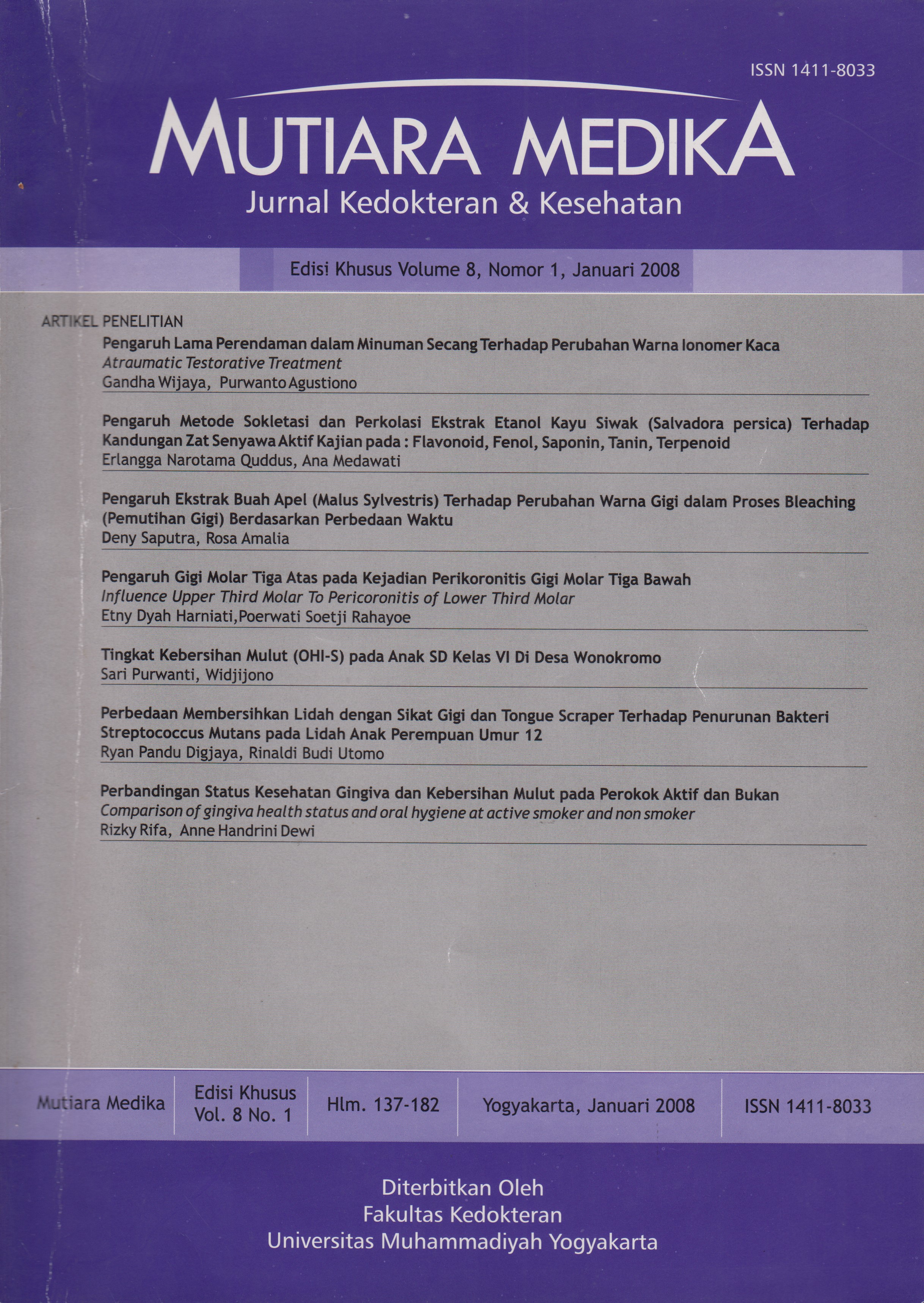Tingkat Kebersihan Mulut (OHI-S) pada Anak SD Kelas VI Di Desa Wonokromo
DOI:
https://doi.org/10.18196/mmjkk.v8i1%20(S).9421Keywords:
Oral hygiene index, Wonokromo village, 6th class of elementary school.Abstract
Oral hygiene is ones of local factor that has a dominant determination in oral disease. In spite of it, the childrens oral health has an influence on good behavior to oral health status. The behavior is a very complex any thing that involves internal or external aspect, even psychological and physical. Elementary at the age of II -1 2 years of school student has already able to think rationally and precisely based on their mperience, along with the family support, in order to keep oral hygiene, but in the village, the reality of oral hygiene is still low.
Based on those thoughts the aim of this research is to found the level of children oral hygiene at the age of II-I2 years. The object of this research is Wonokromo village in the border city of Kebulnen confine between Sawangan village and Kaliputih village. The samples of this research are I13 students that consist of 56 boys and 57 girls from three elementary schools in Wonokromo village. This research uses cross sectional survey to see the level of Oral hygiene in children in the 6"’ year of elementary school. The parameter of this research is oral hygiene index. This research is analyzed by descriptive statistic method with SPSS 14.
The result of this research showed that 1.0 as the lowest number of OHI-S, and the highest on 5.6. The average from all of the samples was 2.9 :1: 0.835 (moderate criteria). The good criteria of oral hygiene was found in boys, beside the moderate and low criteria was found in girls, the chi-square result showed that p = 0.835, that means there is no difference between boys and girls (p>0.05). The conclusion of the research that the children in 6th years of elementary school in the Wonokromo village are on the moderate criteria of oral hygiene (OHI-S) level
References
Boedihardjo. 1985, Pemeliharaan kesehatan gigi dan keluarga, Airlangga University Prees, Surabaya
Carranza's. 2002, Clinical Periodontologi, The Curtis Center Independence Square West Philadelphia, W. B. Saunders Company.
Herijulianti, E., lndriani, S. T., Artini, S. 2001, Pendidikan Kesehatan Gigi, EGC, Jakarta.
Knoers, A. M. P., Monks, F. J., Haditono, S. R. 2004, Psikologi Perkembangan, Pengantar Dalam Berbagai Bagiannya, Gadjah Mada University Press, Yogyakarta.
Manson, J. D. dan Eley, B. M. 1993, Buku Ajar Periodonti, Hipokrates, Jakarta.
Notoatmodjo, S. 1997, Ilmu Kesehatan Masyarakat, Prinip-Prinsip Dasar, Rinneka Cipta, Jakarta.
Narendra, M. B., Sularyo, T. S., Soetjiningsih, Suyitno, H. Gde Ranuh, IG N. 2002, Tumbuh Kembang Anak dan Remaja, IDAI, Jakarta.
Petriasih, 2005, Hubungan Tingkat Pendidikan Ibu Dengan Kejadian Karies Gigi Pada Anak SD, Yogyakarta.
Ratih, A., Yuyus, R. 2006, Hubungan Pengetahuan, Sikap, dan Perilaku Pada Siswa SD Kecamatan Penjaringan, Universitas Indonesia, Jakarta.
Soetjiningsih, 1995, Tumbuh Kembang Anak, EGC, Jakarta.
Sarwono, S. 2004, Sosiologi Kesehatan, Beberapa Konsep Beserta Aplikasinya, Gadjah Mada University Press, Yogyakarta
Downloads
Published
Issue
Section
License
Copyright
Authors retain copyright and grant Mutiara Medika: Jurnal Kedokteran dan Kesehatan (MMJKK) the right of first publication with the work simultaneously licensed under an Attribution 4.0 International (CC BY 4.0) that allows others to remix, adapt and build upon the work with an acknowledgment of the work's authorship and of the initial publication in Mutiara Medika: Jurnal Kedokteran dan Kesehatan (MMJKK).
Authors are permitted to copy and redistribute the journal's published version of the work (e.g., post it to an institutional repository or publish it in a book), with an acknowledgment of its initial publication in Mutiara Medika: Jurnal Kedokteran dan Kesehatan (MMJKK).
License
Articles published in the Mutiara Medika: Jurnal Kedokteran dan Kesehatan (MMJKK) are licensed under an Attribution 4.0 International (CC BY 4.0) license. You are free to:
- Share — copy and redistribute the material in any medium or format.
- Adapt — remix, transform, and build upon the material for any purpose, even commercially.
This license is acceptable for Free Cultural Works. The licensor cannot revoke these freedoms as long as you follow the license terms. Under the following terms:
Attribution — You must give appropriate credit, provide a link to the license, and indicate if changes were made. You may do so in any reasonable manner, but not in any way that suggests the licensor endorses you or your use.
- No additional restrictions — You may not apply legal terms or technological measures that legally restrict others from doing anything the license permits.






